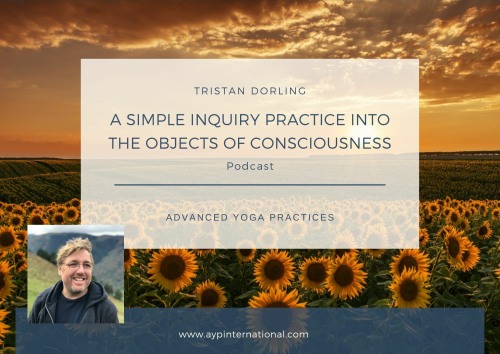A Simple Inquiry Practice Into the Objects of Consciousness
By Tristan Dorling
Transcript from a podcast
15th November 2021
So, one of the things that I sometimes get asked by people is: “How do you begin to approach self-inquiry?”. And so this is something that’s sometimes asked by people who have heard about practices such as asking the question “who am I?”. Or they might have heard about practices such as asking the question: “Who is having this thought?”

But, these practices might seem too inaccessible. If you find yourself trying out these kind of practices, and just feeling confused, then that could be an indication that these practices are perhaps a step further down the line. And they are quite advanced self-inquiry practices or, jnana yoga practices.
One of the practices that I’ve used for many years, and which is perhaps easier to begin with, is an enquiry practice that inquires into the nature of objects. It is an inquiry into the nature of phenomena, or things that can arise, things that we can see, things that we can smell, touch, taste, think about, feel and so on. So an inquiry into the nature of things that are perceived, it can be easier, because it’s not going directly to the question: “Who am I?”. It’s not going directly to inquiry into the Self – Self with a capital S. And so it’s coming at the process of inquiry in a more roundabout way, in a more gentle way.
And the practice works like this: Whenever an object arises in our awareness, in our consciousness, we can ask three questions about it. The first question is: “Is it permanent or is it impermanent?”. The second question is: “Does it lead to lasting happiness or lasting satisfaction?”. And, the third question is: “Is it who or what I am?”.
And so for objects in the world, this is quite an easy practice. So, if we see a tree we can ask ourselves the question: “Is this tree permanent?”. It obviously isn’t, because at some point it will die, and disintegrate into the ground. We can ask ourselves the question: “Is this object going to lead to lasting happiness or lasting satisfaction?”. And because we know its nature is impermanent it obviously isn’t going to. And then we can ask the question: “Is this object who or what I am?”. And it obviously isn’t, because we’re aware of it.
So, with objects in the world, this is a very easy practice. And you can take any object: A mountain, or a cup, or a star, or a river, or a house, and the answers coming up are always pretty easy and they’re always the same.
When the practice becomes a bit more tricky, is when we begin to use mental objects. Objects like thoughts or memories or feelings, because they’re a bit closer to home, and we tend to identify with them a bit more strongly. So, you can see a kind of sticky quality arises when it comes to mental objects.
So, if we see a thought arising in our mind, we can ask the question: “Is this thought permanent or impermanent?”. It’s obviously impermanent because thoughts are very fleeting and they arise and dissolve quite quickly. “Is this thought going to bring lasting happiness or lasting satisfaction?”. And so again, if it’s a thought then it is fleeting and it’s quite impermanent, so it’s not going to bring lasting happiness or lasting satisfaction. And then the third question: “Is this thought who or what I am?”. And this is where the practice becomes a bit trickier, or a bit stickier you could say, because quite often we do identify with our thoughts. We do often tend to think that we are what we think. We identify so strongly with our thoughts that we feel they’re part of us, or part of what makes up who we are.
Essentially, for the purposes of this practice, if we are aware of something, then we are the observer, and then the object that we’re aware of, is the observed. So there is subject and object – there’s this that is observing, which is who we are. And then there’s the thing that arises as an object of consciousness, and that’s what we’re aware of. So, for the purposes of this practice fundamentally, if we’re aware of something then it’s not who we are, it’s not what we are. So this is a process by which we can take a step back. We can come back into being aware of our true nature as pure awareness.
And the same thing can happen with feelings, or emotions. As emotions arise, this is another area that can be quite sticky because we also identify quite often, and quite strongly with our emotions. “I am the person who feels this way”, or “I am the person who has these particular feelings or emotions”.
And so then we can use the same thing – if we’re aware of something, then it’s arising and passing away in our awareness and it’s not who or what we are. So we use the same process, asking the same three questions if a feeling arises: “Is it permanent or impermanent?”; “is it going to lead to lasting happiness or satisfaction?”; and “is it who or what I am?”
And so the practice leads to a stepping back and a stepping back and stepping back. And we’re loosening the grip that the mind often holds over us. And the process of identification with mental objects is often quite strong. It can take time for that that kind of sticky quality to become loosened, and time for attachments to become less. So, with a practice like this, we’re gradually loosening those strongly held attachments that we might have for certain mental objects.
If we use this practice, we can see how the mind gradually becomes calmer as a result of using the practice, and as the mind becomes calmer the practice actually becomes easier. When the mind is more calm and more peaceful, it is actually easier to do a practice like this, and to see how our identification with things can dissolve more easily with a quieter mind.
And so this is still a self-inquiry practice. It is still a nyana yoga practice, just like asking the question “who am I?”. And, it would still be necessary to have some degree of inner silence present in the mind for a practice like this to be effective. So, there is a precondition to using practices like this. That precondition is some degree of the witness, some degree of inner silence present in the mind. Once we’ve got that inner silence present then a practice like this can be a very easy way to begin self-inquiry, an easy way to begin jnana yoga.
And then if we use a practice like this for some time, then gradually we find it easier and easier to use other forms of self-inquiry. They follow on naturally from something like this.
And so, if we’re engaged in yoga, we can use a practice like this at any time during the day. It doesn’t have to be during our practice time on the mat. It could be as we sit quietly under a tree in the park, or at any moment during the day. And we can start off just for ten minutes a day, for example, doing a practice like this. And you can gradually build it up, so you’re practicing for longer durations of time.
It is a practice that I’ve used personally for many years. It’s a very effective practice, and does become a very beautiful practice, as we start to see things just falling away in the mind. We start to see attachments simply falling away as we go deeper into the practice.
Follow-up question
Q.
I listened to the podcast about self inquiry, it’s really a more simple way of doing it. However, I’ve come to a very sticky question: What about the feeling of love? I ask myself is it permanent? And the answer is yes, to a certain extent. I feel it sometimes more intensely and other times less, but I never stop loving, for example my daughter. Does it bring long lasting happiness? Yes, without love there would be no happiness. Is it who I am? Not sure about the answer. Can you help?
A.

Note: The podcast that this commentary has been taken from, can be found on YouTube here. It is also available on Apple Podcasts and Spotify.
